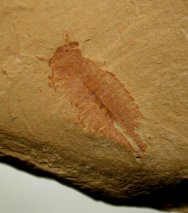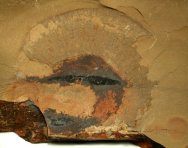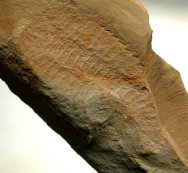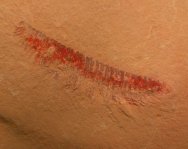Chengjiang Maotianshan Shales Fossils
Early
Cambrian Biota of the Maotianshan Shales of Chengjiang China
|
||
|
|
About Chengjiang Fossil Site: The first unequivocal evidence of multicellular organisms in the fossil record comes from the Ediacaran faunas, named for the Ediacara Hills of Australia where they were first discovered. The earliest of these come from the Vendian period of the Proterozoic, some 565 million years ago. These were soft-bodied organisms, some of which had a "quilted" appearance, which are entirely preserved as impression or compression fossils.
The diversity of soft-tissue fossils at Chengjiang is astonishing: algae, medusiforms, sponges, priapulids, annelid-like worms, echinoderms, arthropods (including trilobites), hemichordates, chordates, and the first agnathan fish make up just a small fraction of the total. Numerous problematic forms are known as well, some of which may have represented failed attempts at diversity that did not persist to the present day. The
fossils are found in a 50 meter thick section of mudstone known
as the Maotianshan Shale, named for a Although fossils from the region have been known since the early 1900s, it was the discovery of the trilobitiform Naraoia longicaudata on July 1, 1984 by Hou Xian-guang that led to the recognition of this exceptional soft-body lagerstatte. Unlike many fossil deposits, those of Chengjiang and the younger Burgess Shale show exceptional preservation of nonmineralized body parts and internal soft tissues, affording us far more information than could be gleaned from preservation of hard skeletal elements alone. The
region that became the Heilinpu Formation was bounded on three
sides by relatively steep mountains, with an opening to the
ocean on the east. Various events of shallowing are evident
in strata above and below indicative of both sea-level changes
and tectonic activity. The climate of the region is thought
to have been tropical and at The Yu'anshan Member extends over tens of thousands of square kilometers of eastern Yunnan Province, and thus the Chengjiang biota is now known from various locations within the region. The biota retains the name of the location at which it was first discovered. Some important locations are at Eriacun, Mafang, Haikou, and Kafuquing. It is at Eriacun that the world's oldest known vertebrates have been found. While
well over 100 species of organisms have been described, approximately
65% of all fossils preserved are arthropods
of exceptional diversity. Among the arthropods, the most abundant
forms The sponges are the second most diverse group after the arthropods with the Desmospongea (tubular sponges) the dominant type. Leptomitus. Leptomitella, and Choialla are examples. The Hexactinellids (glass sponges) are found as well, although they are far more rare. Haliochondrites and Quadrolaminella are examples of this type. Many sponges have been found buried where they lived, and so are often found articulated. The worms are represented by numerous specimens from the Chengjiang biota. The phylum Nematomorpha has been attributed to the genus Cricocosmia which has a long proboscis armed with spines. Some scientists ally it with the Priapulida (priapulid worms), and others with the paleoscolcid worms, indicative of the fact that the taxonomy of members of this fauna is still in a state of flux. Other examples are Maotianshania and Paleoscolex. The Priapulida are represented by Paleopriapulites, Acosmia, Paraselkirkia, and others. The priapulids were a common component of the Cambrian marine faunas of the world. Some of the more unusual members of the fauna are the Lobopodians, creatures that have been commonly termed "velvet worms". Their vermiform bodies bear appendages, hence the other common name of "worms with legs". Most of the fossil lobopodians are marine Cambrian examples. Six genera come from the Cambrian of Yunnan Province, making it the richest source of these unusual creatures. They are Luolishania, Paucipodia, Cardiodictyon, Hallucigenia (also known from the Burgess Shale), Microdictyon, and Onychodictyon. The
phylum Chordata
is that to which all vertebrates belong. Several examples are
found within the Chengjiang biota. As the earliest known vertebrate,
the most reknowned is Myllokummingia which Several enigmatic taxa are known as well. Allonia is a chancelloriid that was initially interpreted as a sponge. Other workers believe that they have their affinity with the tunicates, and still others with the halkeriids. Batofasciculus looks like nothing more than a spiky balloon; the nature of this organism in truly an enigma. Dinomiscus looks much like a typical crinoid, but most researchers are unsure of its taxonomic placement. One worker allies it with Eldonia in the newly-erected class Eldonoidea. Eldonia itself is frequently seen in the biota, sometimes occurring in associations of several individuals. It is typically preserved as a flat, discoidal impression. It was originally described as a medusiod named Stellostomites, but Simon Conway Morris considered it to be a species of Eldonia, a well-known component of the Burgess Shale. The medusoid shape suggests that Eldonia was pelagic; other researchers have argued for an entirely different existence, considering the eldonioids to be benthic, lying passively on the surface of the seafloor. The Chenjgiang Biota is a fabulous assemblage not only by virtue of the diversity and early appearance in the fossil record, but also in view of the exquisite degree of detail of the preservation of its specimens. It affords us a unique opportunity to learn about these wonderful creatures so near the initial radiation of life to the forms of today known as the Cambrian Explosion. This amazing diversity was hailed throughout the world as one of the most important fossil finds of the 20th Century. Because of its unique value to science, the Chengjiang lagerstatte was placed on China's first list of A-class national geological parks in 2001. Chengjiang County has plans to apply for a World Natural Heritage designation for its deposits. Chengjiang is an underdeveloped county having rich phosphate deposits that are found both above and below the formation holding the lagerstatte. They have been exploited in part through efforts that began at about the same time that Hou Xian-guang discovered the deposits that bear these exceptional fossils, with phosphate mining bringing in some 2/3 of the county's revenue in 2003. Efforts are underway to close the region to mining by 2005 to support the county's bid for Heritage Status. A consequence of this has been renewed mining efforts in the region which threaten the fossil-bearing strata due to erosion, slumping of overburden, and simple destruction by the mining efforts. Chengjiang County faces the dilemma between calls for preservation of the treasure trove of early Cambrian fossils to which it is steward and the economic reliance it has on the phosphate industry. It is hoped that a balance between exploitation and restoration of the land can be achieved while there is still time. |
|
|
Fossil Mall Navigation: Navigate
by Fossil Category: l Fossils and Paleotological Science Information l |
||||||

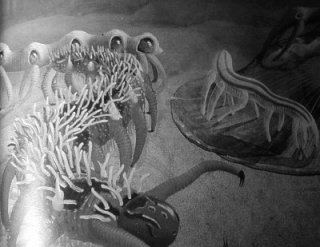 The
The
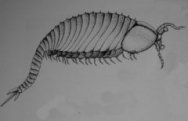 distinctive
hill in Chengiang County, Yunnan Province, China in the Qiongzhusi
Section of the Yu'anshan Member of the Heilinpu Formation. They
occur in thin beds only 1-2 cm thick, with the soft parts preserved
as aluminosilicate films where the structure has been infilled
by iron-rich clay minerals or hematite. The fossils are commonly
weathered to a reddish color, possibly as a result of oxidized
pyrite, on a distinctive yellow matrix. Analysis of some specimens
has shown an iron content as high as 43%, a five-to-eightfold
increase over the background level of the matrix.
distinctive
hill in Chengiang County, Yunnan Province, China in the Qiongzhusi
Section of the Yu'anshan Member of the Heilinpu Formation. They
occur in thin beds only 1-2 cm thick, with the soft parts preserved
as aluminosilicate films where the structure has been infilled
by iron-rich clay minerals or hematite. The fossils are commonly
weathered to a reddish color, possibly as a result of oxidized
pyrite, on a distinctive yellow matrix. Analysis of some specimens
has shown an iron content as high as 43%, a five-to-eightfold
increase over the background level of the matrix.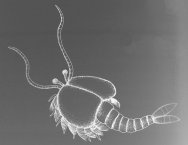 near
equatorial latitude. The Chengjiang fauna is basically a benthic
(bottom-living) one in which most taxa lived directly on the
soft, level seafloor. Few animals that lived above the seafloor
were preserved, perhaps because they were able to flee from
the periodic storm-induced turbidity flows that are presumed
to have resulted in the preservation seen. Most fossils show
evidence of only short-distance post-mortem transportation.
Some sponges have been preserved flat and current-aligned, indicative
of some transport prior to burial, as is also the case for various
burrowing worms. Some specimens, however, have been found exactly
where they had lived, especially in the case of some lingulid
brachiopods which were found with their shells lying flat and
their pedicles extending into the sediment. Most specimens of
all types are preserved with their flattest surface parallel
to the bedding plane of the matrix.
near
equatorial latitude. The Chengjiang fauna is basically a benthic
(bottom-living) one in which most taxa lived directly on the
soft, level seafloor. Few animals that lived above the seafloor
were preserved, perhaps because they were able to flee from
the periodic storm-induced turbidity flows that are presumed
to have resulted in the preservation seen. Most fossils show
evidence of only short-distance post-mortem transportation.
Some sponges have been preserved flat and current-aligned, indicative
of some transport prior to burial, as is also the case for various
burrowing worms. Some specimens, however, have been found exactly
where they had lived, especially in the case of some lingulid
brachiopods which were found with their shells lying flat and
their pedicles extending into the sediment. Most specimens of
all types are preserved with their flattest surface parallel
to the bedding plane of the matrix. are
small bivalved forms known as bradoriids which had pliable exoskeletons.
Few arthropods from Chengjiang had the hard, mineral reinforced
exoskeletons of the type found in the trilobites. Most Early
Cambrian arthropods had relatively pliable, nonmineralized exoskeletons
resembling those of modern-day insects. Indeed, only about 3%
of the organisms known from the Chengjiang biota have hard shells,
with most of those being trilobites. The mud-filled guts of
some arthropods indicate that may have made a living by simply
swallowing mud to extract the nutrients found therein, such
as Fuxianhuia protensa. Others, such as the huge Anomalocaris
saron were active, free-swimming predators. Some researchers
prefer to place the anomalocarids as distinct from the Arthropoda.
As one of the few hard-shelled members of the fauna, the trilobites
are represented by Eoredlichia, Kauyangia, and Yunnanaocephalus.
Examples of all have been found with traces of legs, antennae,
and other details.
are
small bivalved forms known as bradoriids which had pliable exoskeletons.
Few arthropods from Chengjiang had the hard, mineral reinforced
exoskeletons of the type found in the trilobites. Most Early
Cambrian arthropods had relatively pliable, nonmineralized exoskeletons
resembling those of modern-day insects. Indeed, only about 3%
of the organisms known from the Chengjiang biota have hard shells,
with most of those being trilobites. The mud-filled guts of
some arthropods indicate that may have made a living by simply
swallowing mud to extract the nutrients found therein, such
as Fuxianhuia protensa. Others, such as the huge Anomalocaris
saron were active, free-swimming predators. Some researchers
prefer to place the anomalocarids as distinct from the Arthropoda.
As one of the few hard-shelled members of the fauna, the trilobites
are represented by Eoredlichia, Kauyangia, and Yunnanaocephalus.
Examples of all have been found with traces of legs, antennae,
and other details. was first discovered in 1999. Some 500 examples are known, most
of which are flattened imprints of lateral aspect. A series
of V-or W-shaped muscle blocks are evident in most specimens,
with a distinct dorsal fin which has traces of ray-like supports.
At the anteroventral end of the trunk there is a set of six
or seven gill pouches containing feathery gill filaments. All
of these features distinguish this taxon as a vertebrate, one
thought to have affinities with the modern-day hagfish.
was first discovered in 1999. Some 500 examples are known, most
of which are flattened imprints of lateral aspect. A series
of V-or W-shaped muscle blocks are evident in most specimens,
with a distinct dorsal fin which has traces of ray-like supports.
At the anteroventral end of the trunk there is a set of six
or seven gill pouches containing feathery gill filaments. All
of these features distinguish this taxon as a vertebrate, one
thought to have affinities with the modern-day hagfish.